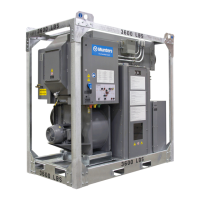Manual# I27028 3-3 Rev. 2 – 11/22/2017
3.2 ABOUT THE R-SERIES UNITS
This is a simplified explanation of the operating principle. Further explanation illustrates
how this principle works in the R-Series unit. Figure 3-3 thru Figure 3-8 show most of the
important parts of the machine: the HoneyCombe
®
wheel, process air stream and
reactivation air stream. However, additional parts are required for the unit to function.
For example, the R-Series unit has two seals, mounted on the wheel plates on each side
of the HoneyCombe
®
wheel. These seals separate the two streams of air – the damp
process air, and the heated reactivation air. Notice that the two air streams move through
the R-Series unit in opposite directions (“counter flow”). The HoneyCombe
®
wheel is
turned by a small drive motor and chain. The drive mechanism is designed to
automatically adjust the chain tension.
The process air is pulled through the wheel by a blower. (Notice that the blower is on the
downstream side of the wheel – it “pulls” rather than “pushes.”) A damper is included
downstream of the blower. By adjusting this damper, the amount of process air moving
through the unit can be changed. This adjustment is important, and it will be discussed
again in the section on “Installation.” A filter is included to keep dirt from the process air
from plugging the wheel.
The reactivation side of the system has some of the same features. The air is pulled
through the wheel by a blower. Again, a damper is included to adjust the reactivation air
flow and a filter to keep the wheel from plugging due to contaminants. Just upstream of
the wheel, the reactivation system includes an electric heater and a direct fired gas
heater. These heaters provide the heat needed to “reactivate” the desiccant. Only one
heat source (electric or gas) is activated at any one time. The gas heat may be provided
by either natural gas or propane fuel.

